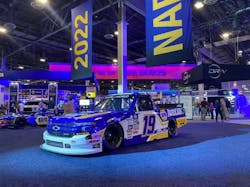AAA VP at NAPA Expo: ‘Good Opportunity For Us in This Business’
July 19, 2022—The auto care industry has a lot to look forward to in the coming decade. That was the message from a live question and answer session featuring Bret Robyck and Margaret Pittelkow during a packed opening day general session at the NAPA Expo in Las Vegas, Nevada.
Robyck, senior vice president of Commercial Sales at NAPA Auto Parts interviewed Pittelkow, vice president of AAA Automotive regarding her organization’s take on the future of the auto care industry.
In opening the session, Robyck asked Pittelkaw about the challenges of the past two years in light of what’s to come. Pittelkow answered that while fuel cost remains a concern, the cost of goods and services has impacted people the most. Surprising to her though, was AAA’s data on the habits of drivers during the Fourth of July holiday despite gas prices at or above $5 per gallon in many places across the United States.
“What did we see on the heels of the Fourth of July? Record-breaking driving—88 percent of families vacationed on the road. Americans love their cars, and they love the open road,” Pittelkow said.
Robyck turned the conversation to electric vehicles and emerging technology. He stated that NAPA believed the trend toward electric vehicles would be a slower progression than many expect. Pittelkow agreed.
“According to the media, EVs are the cat’s meow and bee’s knees. Today, there are 280,000,000 vehicles in operation … and new EV car sales make up less than 10 percent,” Pittelkaw said, mentioning that EV price, range anxiety, and charging infrastructure would need to be addressed before EVs would truly tip the market.
Pitlekaw said AAA handles over 30 million roadside service calls and two things commonly seen in EVs service calls were the need for jumpstarts and tires. “These vehicles are heavier and they're wearing out tires faster,” she said.
Robyck added that NAPA has begun to lean into the EV market to provide more solutions to help shops repair these vehicles.
In a final question, Pittelkaw was asked about the dip in new vehicle sales over the past two years following strong sales from 2016-2019. Robyck reminded Pittelkaw that the average vehicle today has 110,000 miles on its odometer and is 2.5 years old.
“We're expecting two to three years before it changes. That means they need parts, maintenance, and a good repair facility. It's a good opportunity for us in this business,” she said.

